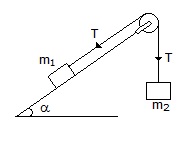A block of mass m1, placed on an inclined smooth plane is connected by a light string passing over a smooth pulley to mass m2, which moves vertically downwards as shown in the below figure. The tension in the string is

A. $$\frac{{{{\text{m}}_1}}}{{{{\text{m}}_2}}}$$
B. $${{\text{m}}_1}{\text{g}}\sin \alpha $$
C. $$\frac{{{{\text{m}}_1}{{\text{m}}_2}}}{{{{\text{m}}_1} + {{\text{m}}_2}}}$$
D. $$\frac{{{{\text{m}}_1}{{\text{m}}_2}{\text{g}}\left( {1 + \sin \alpha } \right)}}{{{{\text{m}}_1} + {{\text{m}}_2}}}$$
Answer: Option D
Join The Discussion
Comments ( 4 )
The resultant of two equal forces P making an angle $$\theta ,$$ is given by
A. $$2{\text{P}}\sin \frac{\theta }{2}$$
B. $$2{\text{P}}\cos \frac{\theta }{2}$$
C. $$2{\text{P}}\tan \frac{\theta }{2}$$
D. $$2{\text{P}}\cot \frac{\theta }{2}$$
A. Equal to
B. Less than
C. Greater than
D. None of these
If a number of forces are acting at a point, their resultant is given by
A. $${\left( {\sum {\text{V}} } \right)^2} + {\left( {\sum {\text{H}} } \right)^2}$$
B. $$\sqrt {{{\left( {\sum {\text{V}} } \right)}^2} + {{\left( {\sum {\text{H}} } \right)}^2}} $$
C. $${\left( {\sum {\text{V}} } \right)^2} + {\left( {\sum {\text{H}} } \right)^2} + 2\left( {\sum {\text{V}} } \right)\left( {\sum {\text{H}} } \right)$$
D. $$\sqrt {{{\left( {\sum {\text{V}} } \right)}^2} + {{\left( {\sum {\text{H}} } \right)}^2} + 2\left( {\sum {\text{V}} } \right)\left( {\sum {\text{H}} } \right)} $$
A. $${\text{a}} = \frac{\alpha }{{\text{r}}}$$
B. $${\text{a}} = \alpha {\text{r}}$$
C. $${\text{a}} = \frac{{\text{r}}}{\alpha }$$
D. None of these

For coplanar cuncurrent and non concurrent force system, their are 3 equilibrium equation
1- algebraic sum of all horizontal force =0,
2- algebraic sum of all vertical force =0,
3- algebraic sum of all moment about any point = 0 ,
So, in this question all are correct, option (d) is correct
First find the accelaration
a = accelaration
T - m1.g.sinα = m1.a
=>T = m1(g.sinα+a)----(1)
m2.g-T=m2.a
=>T=(m2.g - m2.a)-----(2)
add the equation (1) and (2)
m1(g.sinα+a) = (m2.g - m)
=> a =(m2.g - m1g.sinα)/(m1 + m2 )
from the equation 1
T = m1(g.sinα+a)
T = m1(g.sinα+(m2.g - m1g.sinα)/(m1 + m2 ))
T = (m1.m2.g+m2.m2.g-m2.m2.g+m1.m2.g.
sinα)/(m1 + m2 )
T= m₁. m₂.g (1 + sin α)/(m₁ + m₂)
consider b = alpha
T - m1gsinb = m1*a -- Equation 1
m2g - T = m2*a -- Equation 2
Add the equations, you'll get -
m2g - m1gsinb = (m1 + m2)*a
Find a and then substitute it in equation 1 or 2. You'll get T as option D.
Pls explain the ansr.